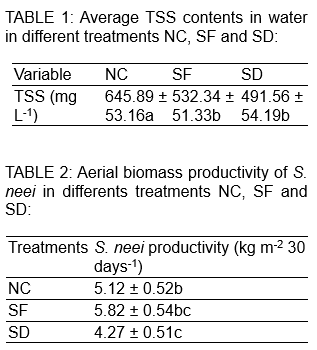DECOUPLED AQUAPONICS SYSTEM WITH Salicornia neei AND Litopenaeus vannamei IN BFT: EFFECTS OF CLARIFICATION OF WATER ON PLANT PRODUCTIVITY
The halophyte Salicornia neei has potential for commercialization and it can be cultivated in aquaponics with waters of marine shrimp farming (Fierro-Sañudo et al., 2020). The use of aquaponics as part of intensive production of the shrimp Litopenaeus vannamei in Biofloc Technology System (BFT) requires integration cultivation modules and plants tolerant to high levels of total suspended solids (TSS) and saline waters (Rakocy, 2012).
The present work evaluated the performance of S. neei in a decoupled aquaponics system in deep water tanks with non-clarified waters (NC), waters clarified by flotation (SF) and by decantation/sedimentation (SD) from a BFT superintensive cultivation of L. vannamei. For each treatment, aquaponics system was set up on three tanks (replicates) with and active volume of 280 L, aeration in the bottom and twenty S. neei plants fixed in a floating raft with 0.15 m² area. Aquaponics systems received waters from a 237 m² raceway stocked with 450 shrimp m-3 along 71 days of a BFT cultivation cycle. The aerial biomass productivity of S.neei were quantified and analyzed with repeated measures ANOVAs.
The average water salinity and temperature in the period of the experiment was 31.2 g NaCl L -1 and 27.8 ºC respectively. The average TSS content of the raceway water was 759.95 ± 59.07 mg L-1. Average reductions in TSS by SF and SD clarification methods were 29.9 and 35.3%, respectively (Table 1). Salicornia neei plants showed excellent growing performance directly over BFT waters, with few differences among treatments. These results can be related to the efficiency of the aeration system that prevented root clogging. Aerial biomass productivity ranged between 4.27 and 5.82 kg m-2 30 days-1 (Table 2). The decoupled alowed high S. neei biomass productivity. This vegetable biomass produced can be used as food, in the pharmaceutical industry or in the production of biofuels.
